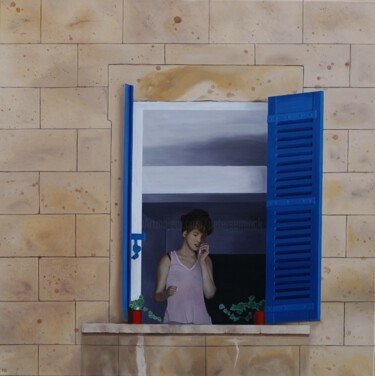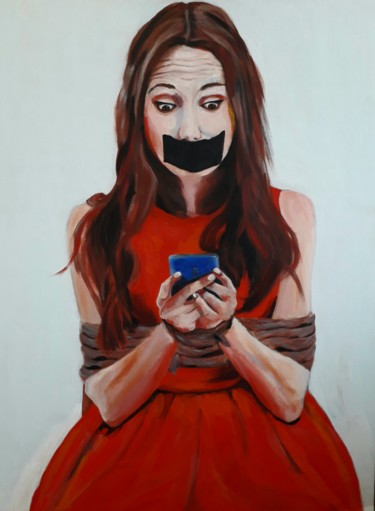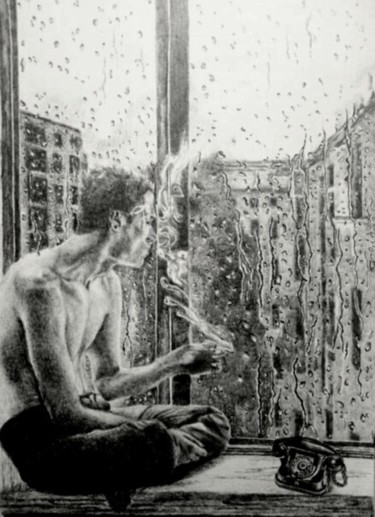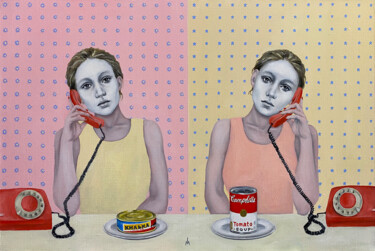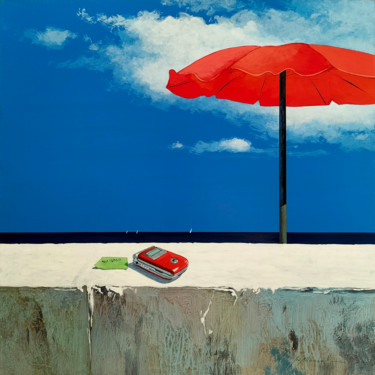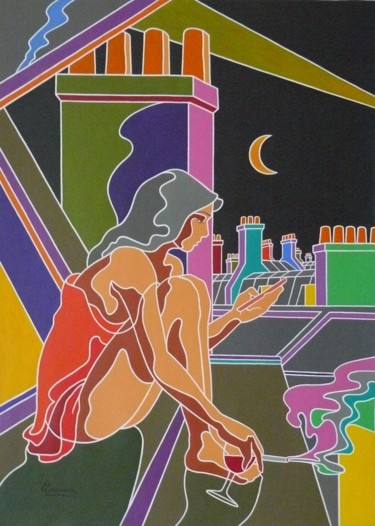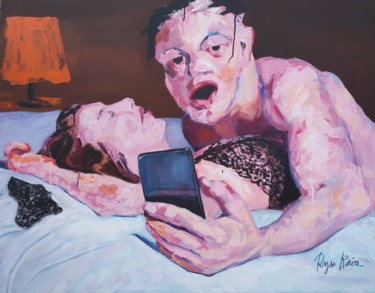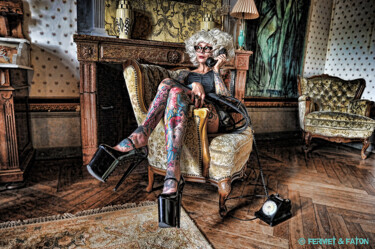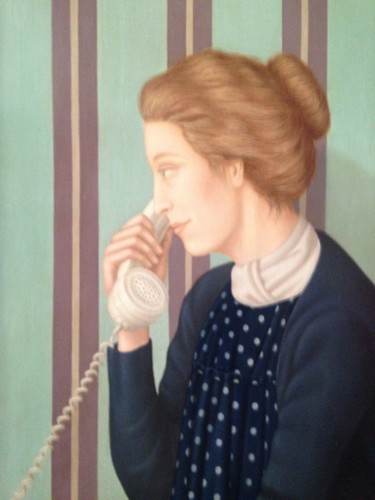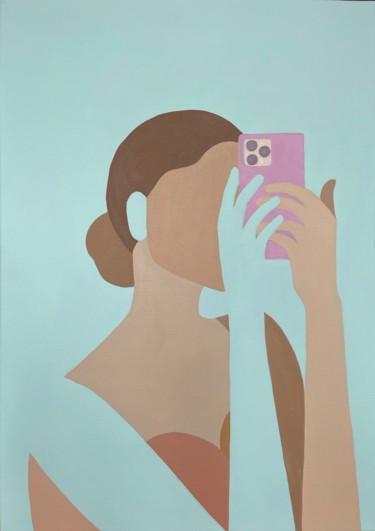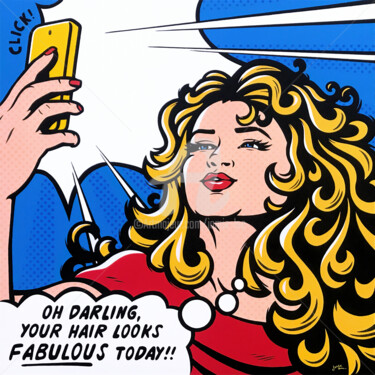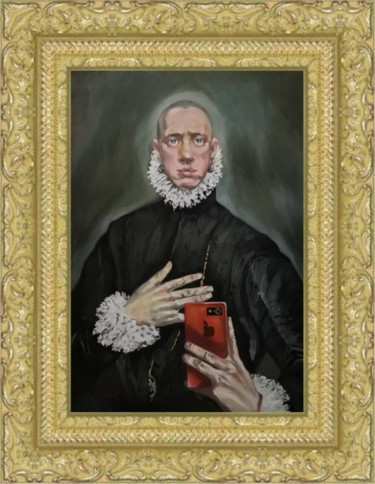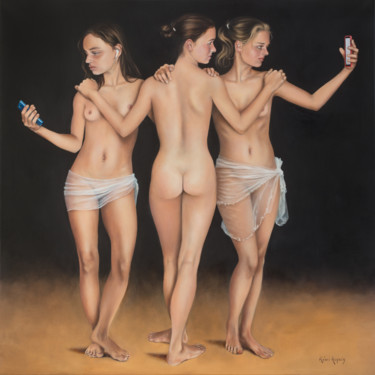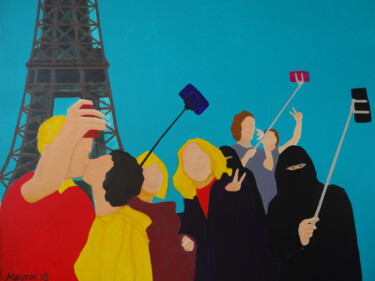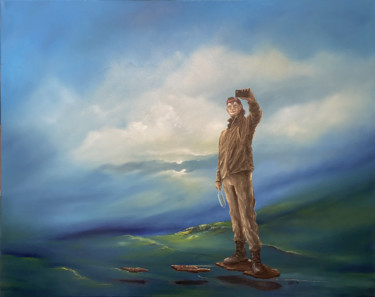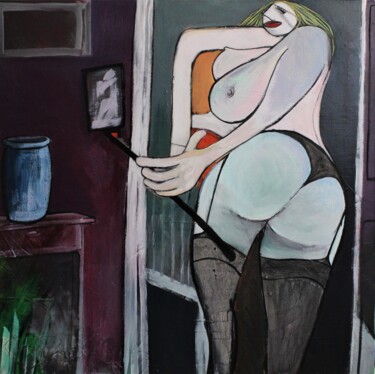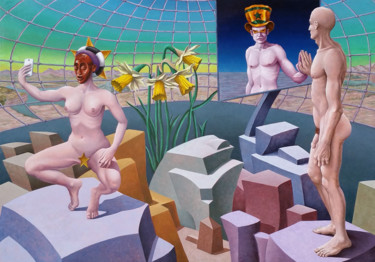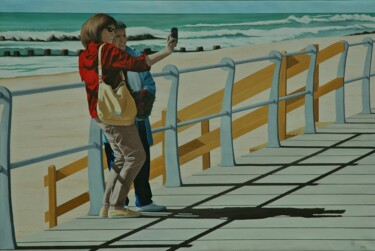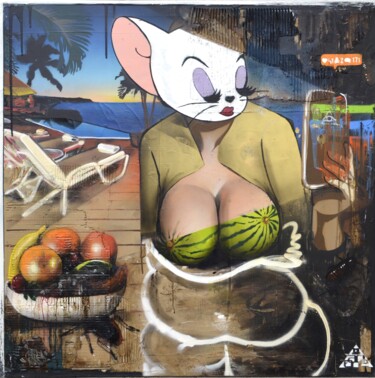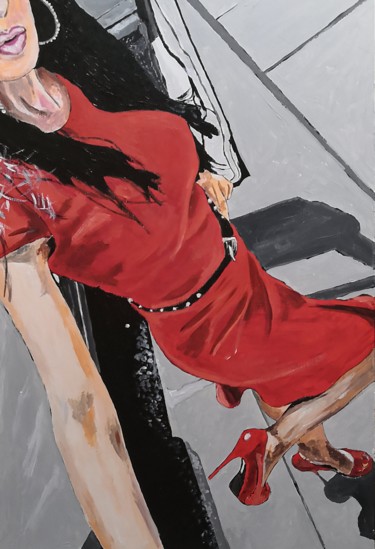 Manuel Morales Sánchez, Selfie. Digital art, different formats available.
Manuel Morales Sánchez, Selfie. Digital art, different formats available.
Introduction to the selfie
The action of portraying oneself on one's own, through a simple self-timer called a "selfie," has now become a common practice as well as a "must" that modern society can no longer give up. This custom, made possible by the extreme practicality, simplicity and speed of contemporary technologies, has inexorably influenced the everyday life of people, who, wanting to keep up with the trends of our time, take selfies in the most diverse everyday situations. Certainly, this somewhat "narcissistic" habit finds its greatest ally in social media, within which users can document, and often flaunt, the more or less relevant moments of their lives.
 Tony Rubino, Classic Hercules takes a selfie, 2021. Acrylic / lithograph on canvas, 50.8 x 38.1 cm.
Tony Rubino, Classic Hercules takes a selfie, 2021. Acrylic / lithograph on canvas, 50.8 x 38.1 cm.
 Ilya Volykhine, Her full attention, 2022. Oil on paper, 178 x 125 cm.
Ilya Volykhine, Her full attention, 2022. Oil on paper, 178 x 125 cm.
But what are the origins of the selfie?
The word "selfie" first appeared within a public forum when, precisely in 2002, it was mentioned by Australian Nathan Hope, who, after a crazy night of celebrating his 21st birthday, posted a photo of his lacerated lip, accompanying it with the following caption: "sorry for the focus, it was a selfie." As in more contemporary self-shots, the premise of that posting was to engage other web users, asking them for advice regarding the stitches she had received. In addition, in support of the origin of the word selfie, there are also the theses of many linguists, who, having analyzed this term, have found it to be typical of the Australian language, where, to abbreviate words, they use to end them with "ie." In any case, Hope's post represents a point of no return; in fact, between 2003 and 2005, the selfie trend evolved into its modern version, becoming increasingly popular thanks to the spread of social media. About the officialization of the word selfie, it occurred in 2013, when, added to the Oxford Dictionary, it was described as: "a photograph taken of oneself, usually with a smartphone or webcam and shared on social media." Later, and more specifically in 2014, that term was named word of the year by the same dictionary.
 Alexandra Van Lierde, Dancing selfie, 2021. Oil on canvas, 100 x 80 cm.
Alexandra Van Lierde, Dancing selfie, 2021. Oil on canvas, 100 x 80 cm.
 Katalin Macevics, Selfie, 2021. Acrylic on canvas, 59.4 x 42 cm.
Katalin Macevics, Selfie, 2021. Acrylic on canvas, 59.4 x 42 cm.
The selfie in the history of art
Are we sure that the first selfie dates back only to 2002?
Certainly, today's selfies are not the same thing compared to the first experiments on the self-timer, dating back to the early days of photography. Nevertheless, the first selfie in history is actually attributable to photographer Robert Cornelius, who, in 1839, took a daguerreotype of himself. To bring this iconic shot to life, the artist had to uncover the lens and quickly run into the frame, holding the pose between three and fifteen minutes, and then put the lens cap back on. Subsequently, and more precisely during the 20th century, the history of the selfie in art continues, in fact, the work of great masters, such as Man Ray, Andy Warhol, Francesca Woodman, Nan Goldin, Cindy Sherman, and Ai Wei Wei, demonstrates how the selfie became a way to experiment and explore one's identity. Speaking of the most important exponent of Pop art, how many of us have in mind Warhol's self-timer in which he holds his polaroid? It is precisely the American master, obsessed with his image, who represents, without a shadow of a doubt, a pioneer of selfie mania, a worthy ancestor of every contemporary serial self-portraitist. Indeed, the hundreds of self-shots portraying Warhol in glamorous, glossy, pop contexts, in an overflowing climate of consumerism, exemplify total creative self-celebration. Such photographs were made by means of the artist's faithful Polaroid camera, to which he was literally a "slave," just as we are today to our smartphones. As for Francesca Woodman, on the other hand, she created her iconic self-shots in abandoned interiors, preferring black and white and sophisticated poses, through which she documented the transition from adolescence to adulthood, lived through her own individual experience. Finally, these photographs can also be considered, in some respects, forerunners of today's selfie, as Woodman, by choosing herself as the protagonist, documented the story of her life.
 Christian Neuman, Rave, 2021. Ink / acrylic on canvas, 100 x 100 cm.
Christian Neuman, Rave, 2021. Ink / acrylic on canvas, 100 x 100 cm.
The selfie in the artworks of Artmajeur
The artists of Artmajeur have created multiple works aimed at celebrating, and documenting, today's cult and spread of the selfie, immortalizing characters in the very iconic moment of a self-shot, aimed at making eternal moments of life, which, in most cases, are distinguished by their total futility. In fact, perfect destination of these selfies are social media, places where lifestyles, identities, trends and propensities, which are often illusory, deceptive and implausibly modified, are flaunted in order to get as many likes as possible. The purpose of all this is to go viral, that is, to promote and spread one's image by doing self-advertising, within a world in which concrete values are often compromised. Narrating this superficial context are the works charged with meanings, reflections and critical views of the contemporary world by Annabelle Amory, Dpart and Jamie Lee.
 Annabelle Amory, Appearances, 2020. Acrylic / collage on canvas, 50 x 50 cm.
Annabelle Amory, Appearances, 2020. Acrylic / collage on canvas, 50 x 50 cm.
Annabelle Amory: Appearances
Born from an invention of Braque and Picasso, collage is an artistic technique based on the juxtaposition of different materials that are glued onto the same support. This procedure, which forces the viewer to reflect on the manner of "assemblage," was born with the purpose of further affirming the artist's freedom, that is, to allow him or her to express themselves through the medium that suits them best. A great many masterpieces of the art world have been made with the collage technique, such as, for example, Matisse's L'Escargot, Hannah Höch's Für ein Fest gemacht and Man Ray's Dora Maar. This tradition continues to take hold in the contemporary world through such masters as Annegret Soltau, Adrian Ghenie and John Stezaker, who are accompanied by the figurative research of multiple Artmajeur artists. It is precisely the latter who have contributed to renewing the themes of the genre, highlighting new points of view regarding modern society. The aforementioned characterizes Annabelle Amory's collages, and acrylics on canvas, which, in addition to investigating the essence of the woman of our times, describe the prevailing contemporary "narcissism." In fact, Appearances, just as per the title, highlights that, behind the modern selfie, stories are often only half-told, where those who immortalize themselves show exclusively a positive and celebratory image of themselves, "forgetting" that they are human, imperfect and eternally dissatisfied with their condition.
 Dpart, Selfiemania. Oil on canvas, 60 x 50 cm.
Dpart, Selfiemania. Oil on canvas, 60 x 50 cm.
Dpart: Selfiemania
Also Dpart's artwork, as per its title, conceals a profound meaning, which is aimed, probably, at ironically criticizing the prevailing popularity of the selfie. In fact, the painting tells us how this trend has even arrived on other planets, where an alien, taking pictures of himself, becomes aware, perhaps a little astonished, of his features. Speaking instead of the relationship between aliens and art history, it is important to highlight clypeology, a brand new and controversial discipline that studies the presence of alleged flying saucers and alien traces in the oldest paintings and pictures. In this context, the Capodimonte Museum in Naples houses one of the most discussed works, namely the Foundation of the Basilica of Santa Maria Maggiore by Tommaso Di Cristoforo Fino. The painting in question depicts the founding scene of the Basilica, immortalizing Pope Liberius, the patricians who own the land, dignitaries and the people as they are intent on celebrating the beginning of construction. What fascinates mystery hunters, however, are the work's clouds, which dark and repeated in the sky, looking like real moving ufos.
 Jamie Lee, Fabulous hair darling, 2021. Acrylic on canvas, 70 x 70 cm.
Jamie Lee, Fabulous hair darling, 2021. Acrylic on canvas, 70 x 70 cm.
Jamie Lee: Fabuous hair darling
Jamie Lee's Pop painting repurposes, in a contemporary version, the figurative style and painting technique of Roy Lichtenstein, a master who, inspired by the billboards and advertising posters of his time, created works with comic traits and, at the same time, cinematic features, that is, in imitation of the iconic movie divas. In fact, Fabuous hair darling inherits, from the work of the American artist, both the blond female subject and the use of the "Ben-Day dots" technique, through which the complexion of the painting's protagonist is illuminated by the superimposition of small dots of different color intensity, highlighted by the drawing's decisive black outlines. The result of the above is a juxtaposition of contrasting shapes and hues, which makes the work attractive and "disturbing" at the same time. On the other hand, regarding the theme addressed by Fabuous hair darling, it is extremely contemporary, as it clearly refers to the world of selfies and social media, on which unnecessary updates on the state of our hair are also often shared.

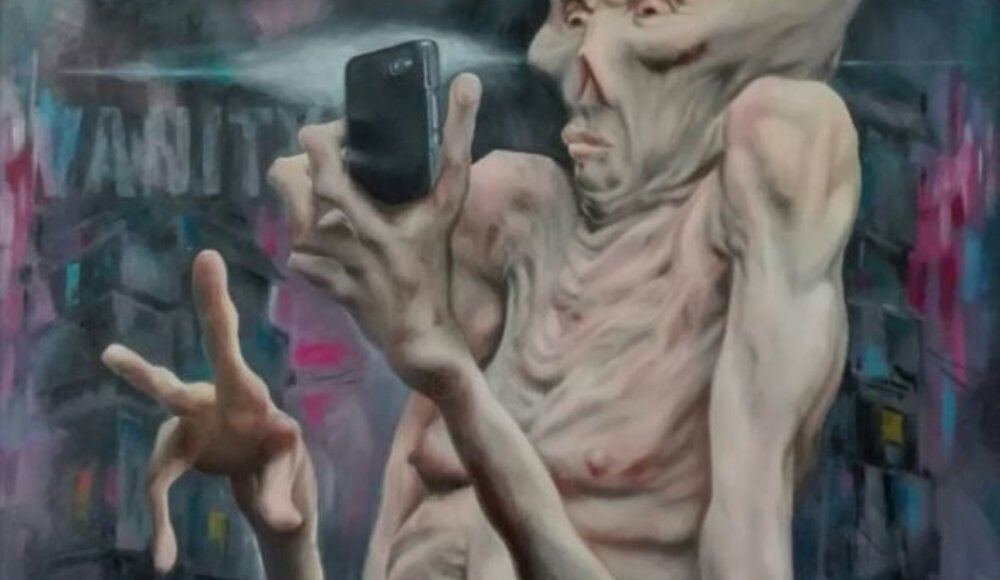
 Olimpia Gaia Martinelli
Olimpia Gaia Martinelli


